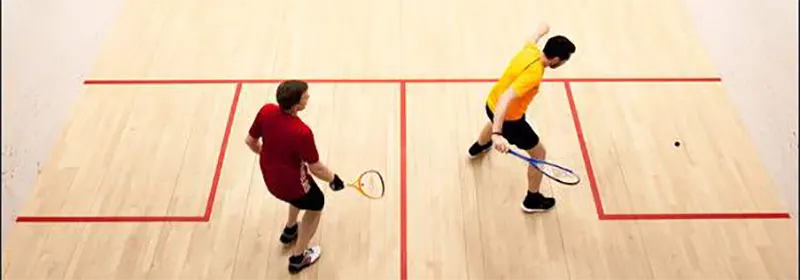01 July 2022 / 3-Min Read / Translate
When you first start playing squash, you might hear lots of rules that other people tell you and many times it’s just players repeating what other players have told them. In the UK we call this “Chinese Whispers“, which is possibly racist. The point is that many people believe some strange “squash rules” that are very far from the truth. Having to let the ball bounce is one of those!
As I said in the introduction, NO!, the ball doesn’t have to bounce in squash. You can hit it before it bounces any time after it has hit the front wall. Remember, after your opponent has hit it, it MUST hit the front wall before you can hit it. That might sound strange, but I have been asked whether players can hit their opponents shots before it hits the front wall!

Did he let the ball bounce?
You MUST volley the ball when you serve – a volley is a shot that is hit before it touches the ground, hence the name Volleyball! You are not allowed to bounce the ball and then hit your serve. You must throw the ball up and then hit it. I mean, you can bounce the ball just before you serve as a mental preparation routine, just like tennis players do.
After the serve, whether you volley or let it bounce is up to you. HOWEVER, I strong recommend volleying service returns with a short block, aiming high on the front wall and hitting it into the same corner as you are standing. This will make the serve move more than if you hit a crosscourt shot. Most new players don’t hit straight because they don’t have confidence in their volleys and the best way to improve them is to practice them!. Remember: Short, block swing and aim high on the front wall.
Well, some shots are hit too hard and low to be able to f=volley, so in those cases, just let the ball bounce first. other times, you just don’t have enough time to volley, maybe because your opponent hit it hard or maybe because you just didn’t expect it to go where it is. There is no exact formula, but I recommend trying to volley about 15/20 percentage of your opponents shots. DO NOT try to count their shots and actually work out your percentage as you are playing, but just have the mentality of looking to volley more.
Rushing your opponent and giving them less time to play their shot is the most important advantage. being rushed often results in playing a weaker shot. However, by volleying the ball you might be rushing yourself, so it is a double-edged sword➚. if you play the volley at the wrong time, you might hit a weak shot, so the decision to volley has to be made in a split-second AND with care.
Make sure you keep your racket above your waist when you are not hitting the ball, i.e. when you are on the T waiting for your opponent to hit the ball, so that you have at least the choice of volleying or not. Don’t worry that the pros might not do that, they spend 20 or 30 hours per week on court, so they have the right to do anything they want.